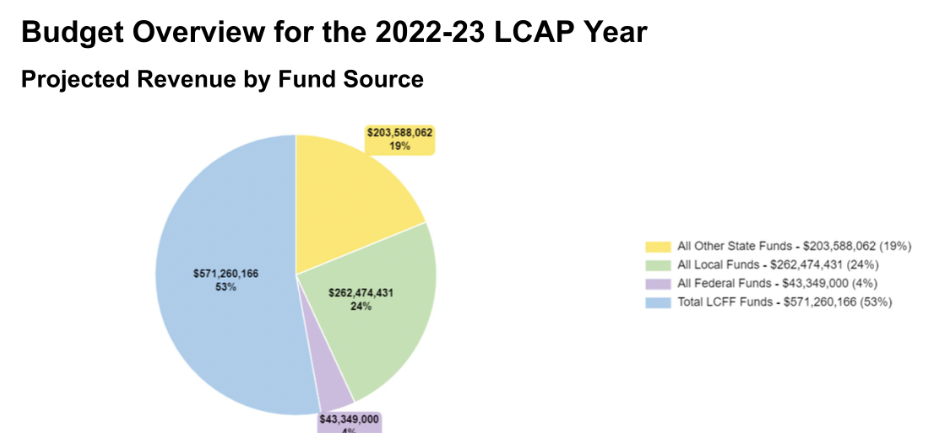What are LCAP and LCFF?
Part of an ongoing series on SFUSD acronyms and the SFUSD budget.
See the SFUSD LCAP webpage for official definitions. Shorter version:
LCFF = Local Control Funding Formula = The largest portion of California state funding that goes to school districts. In order to receive LCFF funds each school district must provide an LCAP to the state.
LCAP = Local Control and Accountability Plan = A document each school district produces with input from the community describing how the school district will spend their budget, including LCFF funds.
The SFUSD LCAP Task Force meets monthly to gather input from the community. Members of the community can easily sign up to attend Task Force meetings and town halls. The LCAP document is finalized before the budget is due July 1st.
What does this look like in practice?
Figures and numbers below are from the FY 2022-23 LCAP and Budget Volume I: Local Control and Accountability Plan (2nd Reading) dated June 28, 2022.
LCAP is a plan for spending almost 100% of the SFUSD budget.
The 2% is explained this way in the document:
Additional Budgeted Expenditures = primarily include support for Special Education and Early Education, facilities and maintenance revenue contributions, and ongoing salary increases for staff funded by parcel tax revenue.
Below is the breakdown of the LCAP revenue budget. LCFF funds were 53% of the total budgeted revenue in 2023. The totals don’t match because the above are expenditures, not revenue.
There is a further breakdown of LCFF funds:
LCFF = The LCFF gives school districts more flexibility in deciding how to use state funds. In exchange, school districts must work with parents, educators, students, and the community to develop a Local Control and Accountability Plan (LCAP) that shows how they will use these funds to serve students.
LCFF Supplemental & Concentration (S/C) Grants = LCFF supplemental and concentration grants the school district will receive on the basis of the number and concentration of high-needs students.
High-Needs Students = Low-income students (as measured by their eligibility for free or reduced-price lunch), children in foster care and students learning the English language.
This gets to another important definition related to school budgets: restricted vs unrestricted funds. Restricted funds must be used for specific purposes/programs while unrestricted funds can be used any way the district sees fit.
It looks like, for the 2022-2023 budget, about 47% of the total (LCAP) budget was made up of unrestricted LCFF funds. Only 11% of LCFF funds are restricted (Supplemental and Concentration grants for high needs students).
The LCAP document divides the overall budget into Actions and Titles. Note that the example above is allocating $316.5 million. It’s not immediately obvious how these descriptions translate into actual budget line items, which outside vendors or SFUSD employees will be paid with them, or how the community can confirm that funds were allocated correctly. This can be a topic for a future blog post.






